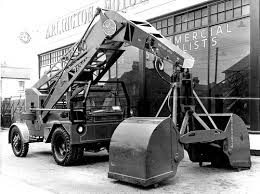Some excavators were mounted on commercial trucks, as were the original truck cranes, and others went on purpose-built crane carriers. In some cases a partial-swing backhoe was simply attached to the back of a truck or a tractor-like chassis.
Eräät varhaiset kaivinkoneet asennettiin kuormautojen rungoille, samankaltaisiin alustoihin joissa monissa oli alkuperäinen pyörivä kuormaus nosturi, mutta toiset valmistajat asensivat ne juuri tätä tarkoitusta varten rakennetun nosturin rungolle.
Joissakin tapauksissa vain osittain kääntyvä traktorin irto-kaivuri oli yksinkertaisesti kiinnitetty ohjaamon taakse kuorma-auton rungolle tai traktorin perävaunu alustalle.
Vaijeri käyttöiset nosturit ja kaivinkoneet käyttävät vinssejä ja teräsköysiä kaikissa työtoiminnoissaan. Vaijeri käyttöisen konee edut on puomi rakenne jonka johdosta rakenne on kevyt, jonka ansiosta se ylettyy työssä hyvin pitkälle, ja suuria vaijeri koneita käytetään ulottuvuuden takia yhä edelleen kaivos- ja vesi rakentamisessa.
Coles Crane
Romania S.C. PROMEX S.A. Braila exavator
Michican 50 crane
Sennebogen SH40, the traditional rope-operated mechanical excavators
Romanian Braila
Crane Taylor Jumbo
---------------------------------------------------------------------------------------------------------------
During World War II Brockway manufactured the B666 heavy truck, including the B666 Daybrook M-II-A bridge erector and C666 Quick Way crane, as well as G547 and G690 6-ton 6×6 bridging trucks, part of a standard design series also built by Corbitt and White.
G547 "Treadway" trucks had a large hoist on the rear for self-unloading, while the G690 chassis were fitted with "Quickway" cranes, also used in bridging operations.
All 6-ton military trucks (of all manufacturers) had Hercules HXD 855 14.0 litr. gasoline engines, developing 202 hp / 151 kW at 2150 rpm and 870 N·m of torque at 900 rpm.
10 inches Electrics: 6 Volt (starter - 12 Volt)
Gearbox: 4 speeds + 1 rear, 2-speed transfer box with front axle declutch.
Brockway B666 Nordwest crane Clutch: dry single plate Axles gear ratio: 7,33:1 double reduction.
Air brakes, Liquid cooling,
Front axle: rigid with semi-elliptic leaf springs,
Rear axle: rigid with inverted semi-elliptic leaf springs.
Quick-Way revolving crane, Maximal speed: 35 mph Tyres: 10,00-20 inches.
Fuel tank capacity: 80 gallon Fuel consumption: up to 75 Ltr./100km
----------------------------
Michigan Kaivinkone ja Nosturi yhtiö oli maailman ensimmäinen yhtiö joka käsitteli tämän ongelman ratkaisua valmistamalla oman rungon nosturille.
Vaunun runko oli rakennettu suuren vetolujuuden teräksestä, jota käytettiin myös suurien ja vahvojen kauhojen valmistuksessa, ja joka oli erityisesti suunniteltu ehkäisemään liiallista rasitusta kuormainta käytettäessä, seikka joka lisää rungon kestävyyttä ja lisää myyntiä.
Yhdistämällä lujuus sekä keveys, tämä mahdollisti nosturin nostaa kuusi tonnia sekä käsittelemään suurta 2 m3 kauhaa.
Huolimatta nopeus sekä liikkuvuuden antamista eduista joita ajoneuvo-nosturi pohjaiset koneet tarjosi, hydrauliset traktorikaivurit ja kaivurikuormaajat eivät oikeastaan koskaan siirtyneet käyttämään suuria maantie siirtymisen ajo-nopeuksia
Oli olemassa kaksi kielteistä seikkaa jotka vastustivat tämän kaltaisia tie-nopeuksia.
--------------
Demac shovel and white frame
Brockway, B666 heavy crane





























